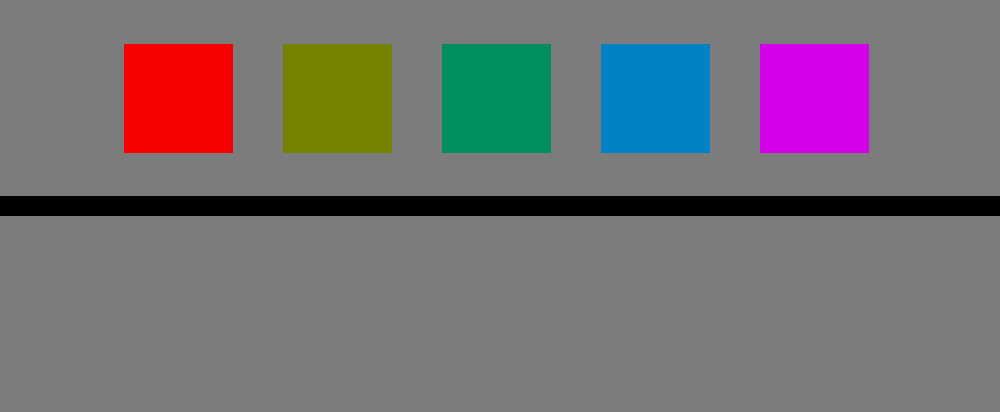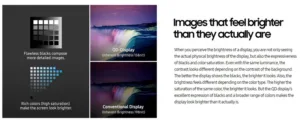
For those that haven’t been following the technology over recent years, Samsung’s QD-OLED technology could be viewed as a development of the approach taken by LG Display in making its OLED TV panels. Samsung’s first project to make large OLEDs was based on using separate RGB pixels, like its smartphone OLEDs. However, one of the tough challenges was in depositing the separate pixels on large substrates. In contrast, LG puts the layers of RGB down on top of each other, without patterning. That creates white light. It separates the colours with filters. This WOLED system works and has made OLED TV possible as a mass production product, but the use of filters throws away a lot of the light that you have made with such difficulty.
Samsung’s QD-OLED takes the idea of not patterning the emitting layer but then uses patterned quantum dots to convert a flat blue emitting system (it’s more than just a layer) to red and green. Some filtering may still be needed, but it’s much less aggressive than the filters used by LG. The filtering may be needed because otherwise you have to use a lot of quantum dots to completely convert the blue light as any blue light leakage reduces the chromaticity range that the display can produce. That’s important.
One advantage of QDs as materials compared to OLEDs is that the emissions of the dots have a very pure colour or a narrow Full Width Half Maximum (FWHM), in the jargon. That means that you have the potential to cover more of the chromaticity range of the BT2020 wide colour gamut. Being able to claim a bigger percentage of coverage is a clear marketing advantage as ‘everyone knows’, don’t they, that bigger specification numbers mean better products, so more sales?
Some QD OLED Details
I noted that at the end of the material on the Samsung Display website, is a section that is headed “Images that feel brighter than they actually are”.
The text highlights that displays with a wider gamut look brighter than those with a narrower colour range and with less saturated colours. That is a well known effect called the Helmholtz Kohlrausch known for convenience reasons as the H-K effect’. For more depth on the effect, there is an article on Wikipedia that covers it.
 Each color on top has approximately the same luminance level and yet they do not appear equally bright or dark. The yellow (second from the left) appears to be much darker than the magenta (right-most). However, when the top image is converted to grayscale, we have the image on the bottom–a single shade of gray. Source:Wikipedia
Each color on top has approximately the same luminance level and yet they do not appear equally bright or dark. The yellow (second from the left) appears to be much darker than the magenta (right-most). However, when the top image is converted to grayscale, we have the image on the bottom–a single shade of gray. Source:Wikipedia
As it happens, I recently saw the August issue of the SMPTE Motion Imaging Journal that includes a lot of technical information about HDR (and is worth a look if you are interested in the details of that technology). One particular paper caught my attention “A Visual Model for Very Wide-Gamut HDR Displays That Accounts for the Helmholtz–Kohlrausch Effect”¹. The paper explains that the researchers found a way, using a specialist measurement system, to measure displays in a very detailed way and used that data to compare it with subjective experiments on perceived brightness. They came up with a model that can be used to ‘predict brightness as a function of colourfulness’. That means that display makers could use the model to either minimise the luminance (the measured light output) needed to achieve particular levels of brightness (the perceived level of output) which could help to reduce power consumption.
However, the research could also be used, I think, to show one how one kind of display with more saturated primaries would look better than one with wider primaries. What a coincidence that such a paper should come out at this time! Hmmm… It turns out that three of the four researchers work for Samsung Display and the fourth did until 2020. The lead author is Dale Stolitzka, the principal engineer at the Samsung Display America Lab, San Jose, CA, who leads display standardization and this location’s Vision Lab. The others are also distinguished display scientists.
All of that suggests to me that the benefits of the H-K effect and the advantages of QD-OLED may well be a significant part of the marketing for QD-OLED by Samsung Display and its partners that will use the technology in their TVs. The research could be used to show how a TV with the same brightness as another, but with more saturated primaries could look better than another. For example, a QD-OLED vs LG’s WOLED.
Don’t misunderstand me. I have absolutely no problem with Samsung backing up marketing claims with research published in independent journals. If every marketing claim was based on such firm foundations, the world would be a better place! (BR)
D. Stolitzka, J. -H. Chong, C. Lee and J. Kwag, “A Visual Model for Very Wide-Gamut HDR Displays That Accounts for the Helmholtz–Kohlrausch Effect,” in SMPTE Motion Imaging Journal, vol. 130, no. 7, pp. 22-30, Aug. 2021, doi: 10.5594/JMI.2021.3083571.

